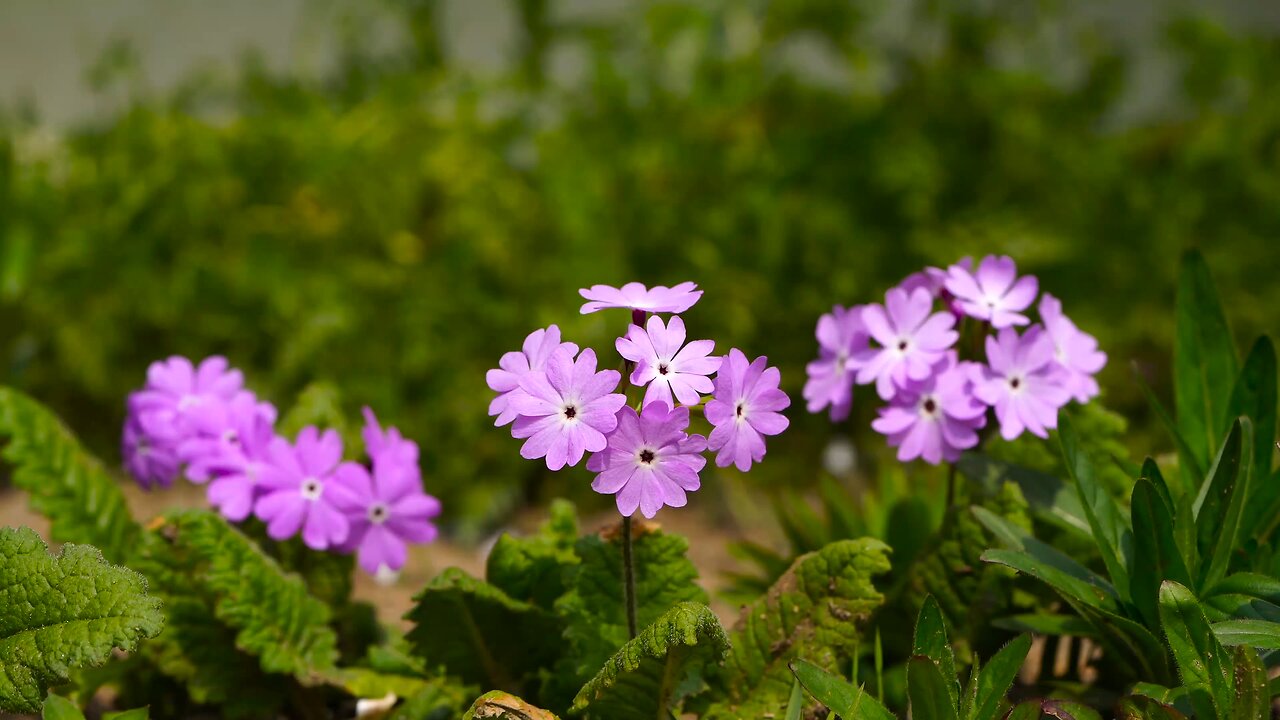Premium Only Content

"Japanese Primrose: A Delicate Beauty for Your Garden"
The Japanese primrose (*Primula sieboldii*), also known as Siebold's primrose, is a beautiful flowering plant native to Japan and parts of East Asia. It is known for its vibrant blooms and delicate appearance, making it a popular choice for gardens and ornamental landscapes.
### **Description**
- **Common Names**: Japanese Primrose, Siebold's Primrose
- **Family**: Primulaceae (Primrose family)
- **Genus**: *Primula*
- **Species**: *P. sieboldii*
- **Appearance**: The Japanese primrose is a herbaceous perennial plant that typically grows to about 20-40 cm (8-16 inches) in height. It features broad, heart-shaped leaves with scalloped edges and produces clusters of delicate, flat-faced flowers. The flowers come in shades of pink, purple, and white, often with a contrasting eye or stripe.
### **Habitat and Distribution**
- **Native Range**: *Primula sieboldii* is native to Japan, China, and parts of Korea and Russia. It naturally grows in moist, shaded environments such as along stream banks, in wet meadows, and in woodland areas.
- **Preferred Habitat**: The plant thrives in partial to full shade and prefers consistently moist, well-drained soil that is rich in organic matter.
### **Cultivation**
- **Growth Conditions**: Japanese primrose prefers cool, moist conditions and is best suited for gardens with partial shade. It can tolerate full sun in cooler climates but should be protected from the intense midday sun in warmer regions.
- **Propagation**: The plant can be propagated by division in early spring or by seed. Seeds should be sown in the fall or early spring and require cold stratification to germinate.
- **Maintenance**: Regular watering is essential to keep the soil consistently moist, especially during dry periods. Mulching can help retain moisture and maintain cooler soil temperatures.
### **Uses**
- **Ornamental**: *Primula sieboldii* is widely grown as an ornamental plant in gardens, particularly in shaded borders, woodland gardens, and alongside water features. Its colorful and delicate flowers make it a striking addition to spring gardens.
- **Cultural Significance**: The plant holds cultural importance in Japan, where it is often featured in traditional gardens and flower arrangements. It is also a symbol of early spring in Japanese culture.
### **Varieties and Cultivars**
- There are several cultivars of *Primula sieboldii* with varying flower colors and patterns. Some popular cultivars include:
- ‘Snowflake’: White flowers with a slight pink blush.
- ‘Murasaki-shikibu’: Deep purple flowers with white eyes.
- ‘Pink Sensation’: Bright pink flowers with a white center.
### **Care Tips**
- **Watering**: Keep the soil consistently moist, but avoid waterlogging, which can lead to root rot.
- **Fertilizing**: Apply a balanced fertilizer in early spring to encourage healthy growth and blooming.
- **Winter Care**: In colder climates, the plant may die back to the ground in winter, but it will resprout in the spring. Mulching in the fall can help protect the roots from freezing.
### **Pests and Diseases**
- *Primula sieboldii* is relatively pest-free but can occasionally be affected by slugs, snails, and aphids. Good garden hygiene and the use of organic pest control methods can help manage these issues.
### **Interesting Facts**
- The species name *sieboldii* honors Philipp Franz von Siebold, a German physician and botanist who was instrumental in introducing many Japanese plants to the West in the 19th century.
- The plant is part of a larger group of primroses known as the "candelabra primroses," known for their tiered flower arrangements.
The Japanese primrose is a delightful addition to any garden, offering a touch of elegance and vibrant color in shaded areas. If you have more specific questions about this plant, feel free to ask!
-
 1:37:15
1:37:15
CocktailsConsoles
2 hours agoBE PART OF THE GAME!!| Death Road to Canada | Cocktails & Consoles Livestream
16.9K -
 1:04:29
1:04:29
BonginoReport
8 hours agoFDA Vax Pusher Needs to Look in the Mirror - Nightly Scroll w/ Hayley (Ep.16) - 03/31/2025
114K78 -
 3:27:31
3:27:31
SquallRush
1 day agoBrawlhalla Mondays!
20.8K -
 LIVE
LIVE
Misfit Electronic Gaming
7 hours ago $1.46 earned"LIVE" It's So Monday So lets Perk it up. Lets Earn Gears"Party Animals" & R.E.P.O. Who will join me????
309 watching -
 54:13
54:13
Sarah Westall
7 hours agoCIA Disclosures: Ark of the Convenient, the Pyramid Code, Ley Lines & Earth’s Energy w/ Jason Shurka
84.9K23 -
 1:16:28
1:16:28
Kim Iversen
9 hours agoThere Was No COVID Virus! How We've All Been Duped By The Medical Establishment
151K302 -
 2:58:42
2:58:42
Crossplay Gaming!
5 hours agoLet's Check Out MORE Metroid Prime Remastered! (With the RTX 5090!)
41.9K3 -
 14:24
14:24
AlaskanBallistics
13 hours ago $1.31 earnedMDT HNT26 Chassis on A Remington 700 7mm Remington Magnum
34.3K7 -
 13:34
13:34
T-SPLY
9 hours agoCNN Is Now Accusing Trump Staff Of War Crimes
55.7K25 -
 1:33:25
1:33:25
2 MIKES LIVE
9 hours ago2 MIKES LIVE #199 Deep Dive Monday!
43.6K5